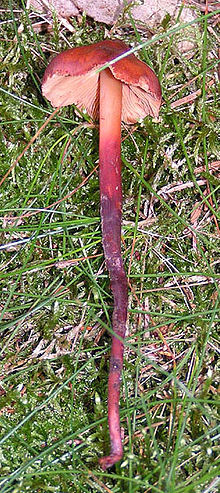Phaeocollybia is a genus of fungi in the family Hymenogastraceae.[2] They are characterized by producing fruit bodies (mushrooms) with umbonate caps and rough brown spores. The genus is widely distributed (especially in temperate regions), and contains about 50 species.[3] They are known for a long stipe which continues down into the ground, known as a rooting stipe or pseudorhiza formed as the fruitbody grows up from the subterranean colonized roots well below the organic soil layer. The genus is primarily mycorrhizal but may also be somewhat parasitic on forest trees.[4]
| Phaeocollybia | |
|---|---|

| |
| Phaeocollybia jennyae | |
| Scientific classification | |
| Kingdom: | |
| Division: | |
| Class: | |
| Order: | |
| Family: | |
| Genus: | Phaeocollybia R.Heim (1931)
|
| Type species | |
| Phaeocollybia lugubris (Fr.) R.Heim (1931)
| |
| Synonyms[1] | |
|
Quercella Velen. (1921) nom. rej. | |
Molecular phylogenetic work during the 2000s suggests a close relationship to Galerina.
Taxonomy
editThe genus was circumscribed by mycologist Roger Heim in 1931.[5] The name Phaeocollybia is conserved against the earlier but obscure name Quercella. Phaeocollybia means dusky Collybia which actually refers to the brownish spore print in contrast to the white spore print of Collybia in the traditional sense.
Description
editPhaeocollybia is defined as mushrooms, with a glutinous or moist or sometimes dry and innately scaly, conic, umbonate cap, a rooting, cartilaginous to wiry stipe, generally lacking a visible veil or cortina or with faint traces, and spores which are brown in deposit. The spores are ornamented but will lack a germ pore or plage. The most distinctive feature microscopically is the presence of tibiiform[6] cystidia or branches on the mycelium and mycorrhizal sheaths.
See also
editReferences
edit- ^ "Phaeocollybia R. Heim 1931". MycoBank. International Mycological Association. Retrieved 2011-02-17.
- ^ Matheny PB, Curtis JM, Hofstetter V, Aime MC, Moncalvo JM, Ge ZW, Slot JC, Ammirati JF, Baroni TJ, Bougher NL, Hughes KW, Lodge DJ, Kerrigan RW, Seidl MT, Aanen DK, DeNitis M, Daniele GM, Desjardin DE, Kropp BR, Norvell LL, Parker A, Vellinga EC, Vilgalys R, Hibbett DS (2006). "Major clades of Agaricales: a multilocus phylogenetic overview" (PDF). Mycologia. 98 (6): 982–95. doi:10.3852/mycologia.98.6.982. PMID 17486974.
- ^ Kirk PM, Cannon PF, Minter DW, Stalpers JA (2008). Dictionary of the Fungi (10th ed.). Wallingford: CABI. p. 515. ISBN 978-0-85199-826-8.
- ^ Norvell, L.L.; Exeter, R.L. (2008). Phaeocollybia of Pacific Northwest North America. U.S. Dept. of the Interior, Bureau of Land Management, Salem District. pp. 1–227. ISBN 978-0-9791310-1-1.
- ^ Heim R. (1931). "Le genre Inocybe". Encyclopédie Mycologique (in French). 1: 70.
- ^ In the shape of a tibia bone, that is, with a long narrow neck with an apex that is swollen into a knob, like a tibia.